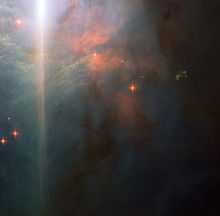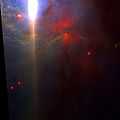NGC 2023
| reflection nebula | |
|---|---|
| emission nebula | |
 NGC 2023 picture created from multiple images taken with the Wide Field Camera of Hubble’s Advanced Camera for Surveys. | |
| Observation data: J2000 epoch | |
| Right ascension | 05h 41m 37.9s[1] |
| Declination | −02° 15′ 52″ |
| Distance | 1467.7 ly (450 pc) |
| Apparent dimensions (V) | 10′x10′ |
| Constellation | Orion |
| Designations | NGC 2023, LBN 954, VDB 52, [XT95] 6, GN 05.39.1.02, RAFGL 806, [NYS99] C-23, IRAS 05391-0217, RX J0541.8-0217, [RK68] 38 |
NGC 2023 (also known as LBN 954) is a reflection nebula located in the constellation of Orion (The Hunter).[2]
Regarding infrared wavelengths, it is a heavy source of fluorescent molecular hydrogen emission,[3] and at 4 light-years wide, it is one of the largest reflection nebulae in the sky. It is powered by an extremely hot B-type star (B1.5), called HD 37903, the most luminous member of a cluster of young Herbig–Haro objects that illuminate the outermost material in the Lynds 1630 molecular cloud (Barnard 33) in Orion B.
NGC 2023 forms a cavity in the surface of the cloud, some 450 parsecs from Earth. It produces a bright visual reflection nebula and an ultraviolet-excited photodissociation region. It is about a third of a degree from the Horsehead Nebula [4] and is often included (but not labeled) in images of that object.
Additionally, one of the defining features of NGC 2023 — the overtly bright streak often seen in the upper-left hand corner — is not a true feature. Instead, the flare is an artifact generated by Hubble’s optics.[5]
Gallery
-

South part of NGC 2023 by HST, 3′ view
References
- ↑ "SIMBAD query result for NGC 2023". SIMBAD Astronomical Database. Retrieved 25 July 2011.
- ↑ "NGC Objects: NGC 2000 - 2049".
- ↑ http://adsabs.harvard.edu/full/1998PASA...15..194B
- ↑ http://www.fromquarkstoquasars.com/apotd-ngc-2023/
- ↑ http://www.spacetelescope.org/images/potw1130a/
External links
- NGC 2023 on WikiSky: DSS2, SDSS, GALEX, IRAS, Hydrogen α, X-Ray, Astrophoto, Sky Map, Articles and images
| ||||||
Coordinates: ![]() 05h 41m 37.9s, −02° 15′ 52″
05h 41m 37.9s, −02° 15′ 52″
| ||||||||||